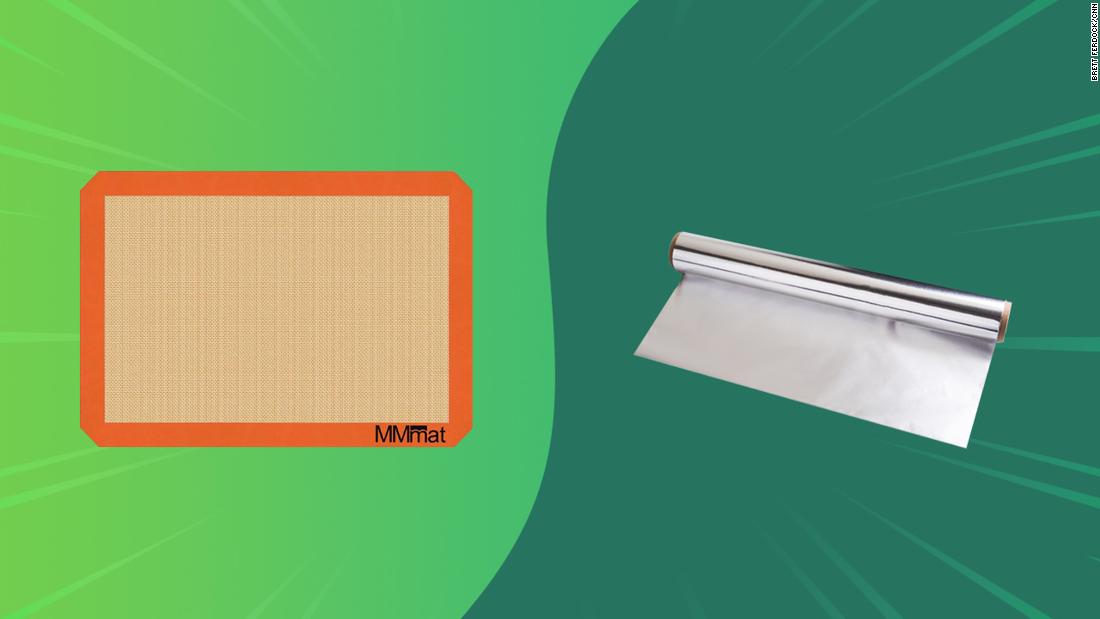All products are independently selected and reviewed by CNN Underscored editors. When you buy through links on our site, we may earn a commission. Learn more
What’s in this guide
This article is part of CNN Underscored’s Earth Week, a weeklong focus on our planet and ways to celebrate and preserve it. We’ll be featuring tips on how to live more sustainably, products to help you spend more time in nature and exclusive deals all week, so check in every morning to see what’s new and be sure to subscribe to the CNN Underscored newsletter to see it all.
Here at CNN Underscored, we love finding and testing sustainable swaps that can help reduce waste in your day-to-day life. We’ve already sung the praises of bidets, Stasher bags, Swedish dishcloths and much more, but our latest love is the humble silicone baking mat.
Contributing writer Kate Bratskeir uses them nearly every day, and they’ve helped her cut aluminum foil and parchment paper out of her life entirely.
MMmat Half Sheet Silicone Baking Mats, Set of 2
Once you start using silicone baking mats, you’ll wonder how you ever cooked without them. The mats are available in single packs, two-packs and even three-packs, as well as in multiple sizes and shapes.
Silicone mats like these are available in various brands, colors, shapes and sizes, but the MMmat Silicone Baking Mats in orange are the very product Bratskeir has been using for the past two years. She stores them folded in half with her cutting boards and would guess that she uses them at least five times a week.
So, what’s so great about these flimsy little things? Their biggest benefit is that they render single-use tinfoil and parchment paper nearly useless. Before these mats, Bratskeir would tear off a new piece of aluminum foil almost every time I put something in the oven. From leftover pizza to uncooked salmon to cookie dough to veggies drizzled in olive oil, every food would get a fresh sheet of foil to separate it from the baking sheet.
While baking sheets are meant to be cleaned regularly, this isn’t something that happens with reliable certainty in many households. Sheets can be rife with burn stains and sometimes sticky with an oily residue even after a cleanse in the dishwasher. Cooking with the silicone baking mats, which — praise the powers that be — are dishwasher-safe, makes Bratskeir confident that whatever food she’s making will not be contaminated by what’s left on the sheet. Plus, the mats will help keep the baking sheet from getting dirty.
The silicone sheets are rated to withstand oven temperatures up to 500 degrees Fahrenheit and are safe in the freezer too. They are truly nonstick and incredibly easy to wipe clean. Some reviewers say they even use the sheets to line their refrigerators — they’d definitely stay in place — to keep everything spotless.
Buying something new is rarely the best option when it comes to practicing sustainability. But we believe these are worth the purchase because they so drastically cut down the need for single-use sheet liners. They can last for years too. One way to ensure they last is to avoid cutting directly on top of them, since it’d be possible for a sharp knife to slice into the silicone and eventually tear a hole.
While tossing away foil is hardly the biggest environmental offense in many kitchens (and actually, aluminum foil is recyclable in many municipalities if you do it correctly), these reusable sheets are a win in our book when it comes to making small changes to cut down on waste.
Zachary Cartwright, lead food scientist at AQUALAB by Addium with a doctorate in food science and a member of IFT’s food safety and quality management division, gave our team some insight into how to find the best silicone baking mat. If you already have a silicone baking mat but aren’t sure if it’s high quality, he gave us a trick to check before you use it again: “Lower-quality mats may contain plastic fillers that release odors or smoke. Bend the mat, and if you see white streaks, it’s a red flag.” He also told us food-grade silicone should be labeled as BPA-free, LFGC- or FDA-certified. Other features to keep an eye out for are a reinforced mesh core, temperature resistance up to 428 degrees Fahrenheit, and dishwasher-safe and stain-resistant labels.
The following FAQs were answered by food scientists Zachary Cartwright and Abbey Thiel.
Cartwright and Thiel noted that silicone baking mats are safe for cooking and baking as long as they are made from food-grade silicone. “This type of silicone has great thermal stability,” Thiel said. “Always make sure the product is made of FDA-approved silicone. This means the silicone is tested for quality and safety, and meets specific regulatory requirements that make it safe to use with food. This type of silicone is made to be heat-resistant, it doesn’t degrade, and it’s is nontoxic, tasteless and odor-free.”
“Silicone mats are reusable, nonstick and easy to clean,” Cartwright said. “Parchment paper is coated with silicone — convenient [but] not reusable or eco-friendly.” One is not inherently better than the other, but the various mediums for keeping your pans free from mess offer different features. Cartwright said parchment paper is oven-safe to about 420 degrees Fahrenheit, while food-grade silicone baking mats are safe to temperatures of up to 428 degrees Fahrenheit. Some mats are considered safe to use at higher temperatures, such as the MMmat and it’s maximum of 500 degrees Fahrenheit, but he noted that silicone baking mats are not suitable for broiling.
For this article, we consulted the following experts to gain their professional insights.
CNN Underscored has a team of skilled writers and editors with many years of experience testing, researching and recommending products, and they ensure each article is carefully edited and products are properly vetted. We talk to top experts when applicable to make certain we are testing each product accurately, recommending only the best products and considering the pros and cons of each item.
The writer for this article, contributor Kate Bratskeir tested MMMat silicone baking mats, while writer Ellen McAlpine spoke with experts in the food science field to uncover what makes a silicone baking mat safe, why it’s worth the buy and what to look for while shopping for silicone baking mats.
Ellen McAlpine is a writer for CNN Underscored, contributing to updates across the site’s many verticals — from lifestyle to tech — as well as writing the occasional original piece. In her free time you’ll find her cheering on the Yankees, testing new recipes and trying the latest fitness classes.
Latest Articles
More recommendations
Note: The prices above reflect the retailers’ listed price at the time of publication.



